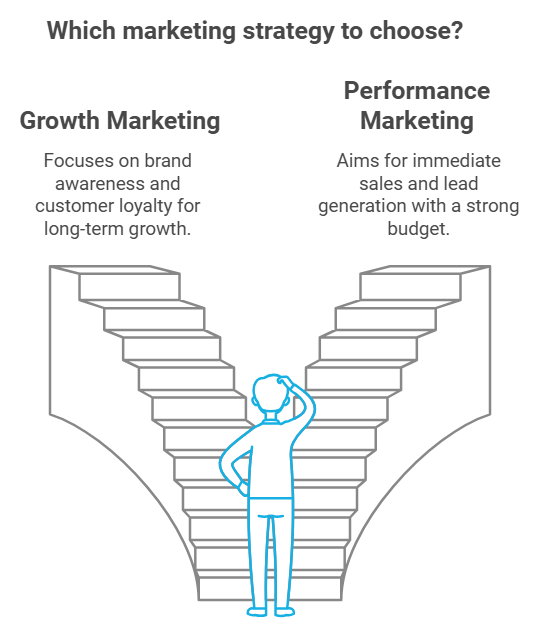What Is A Sales Development Representative (SDR)? Role, Skills, Qualifications, Challenges
More and more companies are hiring SDRs to help with their sales process and increase revenue.

Understand the differences between growth marketing and performance marketing, their goals, and how they drive business success.
In the fast-paced world of digital marketing, businesses are constantly searching for the right strategies to propel their growth. Two popular yet often confused approaches are growth marketing and performance marketing.
While they share some similarities, they are fundamentally different in their goals, tactics, and outcomes. In this article, we’ll dive deep into these two marketing methods, explore their core differences, and help you determine which approach best suits your business needs.
Growth marketing is a holistic approach that prioritizes sustainable business growth over short-term gains. It focuses on the entire customer journey, employing a wide range of tactics from acquisition to retention.
Unlike traditional marketing methods, growth marketing is heavily reliant on experimentation, data-driven decision-making, and constant iteration. The goal is not only to acquire customers but also to build long-term relationships that lead to customer loyalty and advocacy.
Growth marketing employs several tactics that work together to achieve its overarching goal of sustainable growth:
Performance marketing, as the name suggests, is all about achieving measurable, immediate results. Whether it’s generating leads, driving conversions, or increasing revenue, performance marketing is focused on achieving specific outcomes.
Unlike growth marketing, which takes a long-term approach, performance marketing prioritizes immediate, quantifiable results, often through paid advertising channels.
Here are some of the most common tactics used in performance marketing:
The fundamental difference between growth marketing and performance marketing lies in their goals. Growth marketing seeks to build long-term customer relationships and increase customer lifetime value. It’s about understanding the customer journey and creating strategies that enhance every stage of that journey.
On the other hand, performance marketing is much more transactional. Its primary objective is to generate leads, conversions, or sales as quickly as possible. If it’s not measurable and immediate, it’s not performance marketing.
Growth marketing takes a full-funnel approach, considering every aspect of the customer’s journey—from the moment they become aware of your brand to their decision to become a repeat customer.
This includes strategies aimed at improving customer retention, reducing churn, and encouraging brand advocacy. It’s a comprehensive strategy aimed at fostering long-term growth.
In contrast, performance marketing focuses on top-of-the-funnel tactics. It’s all about getting customers to convert in the shortest time possible. Strategies like PPC campaigns and affiliate marketing focus on driving traffic and immediate sales but may neglect the deeper aspects of customer engagement and retention.
Growth marketing is a marathon, not a sprint. It’s about long-term strategies that build brand loyalty, customer retention, and continuous growth over time. You won’t see instant results, but the payoff comes in the form of loyal customers who contribute to sustained growth.
Performance marketing, however, is more of a sprint. It’s designed to generate fast, measurable results. Campaigns are launched with clear objectives and key performance indicators (KPIs) in mind, such as leads, clicks, or purchases, that can be tracked in real time.
The choice between growth marketing and performance marketing ultimately depends on your business goals and stage of growth. For startups looking to build brand awareness and foster customer loyalty, growth marketing may be the best choice. This approach allows businesses to grow organically while focusing on long-term relationships.
If your goal is immediate sales or lead generation, performance marketing is likely the better fit. Businesses with a strong budget for paid advertising often turn to performance marketing to quickly boost their revenue.
Budget plays a significant role in deciding between growth and performance marketing. Growth marketing typically requires a longer investment of time and resources. Experimentation and customer lifecycle strategies take time to develop, which can stretch your marketing budget. However, the long-term rewards, such as higher customer retention rates and loyalty, often outweigh the costs.
On the other hand, performance marketing delivers quicker results but can be resource-intensive upfront. Paid ads, influencers, and affiliate networks all come with costs, and the returns can fluctuate based on market conditions. Companies must carefully track their performance to ensure they’re getting the best return on investment (ROI).
Understanding your market and customer base is crucial when choosing the right strategy. Growth marketing is ideal for businesses that want to cultivate a strong, engaged customer base. If your customers tend to be loyal and long-term, focusing on retention and lifecycle marketing may yield higher returns.
In contrast, performance marketing can be ideal if your target customers are transactional. If your business operates in a highly competitive market with short sales cycles, performance marketing can help you stand out and achieve fast results.
Though growth and performance marketing may seem like opposites, they don’t have to be mutually exclusive. The most successful businesses often combine elements of both strategies to create a balanced approach.
Growth marketing can help lay the foundation for long-term success, while performance marketing can provide the short-term wins needed to sustain operations.
For example, a business might use performance marketing to drive traffic and generate leads through PPC campaigns. At the same time, growth marketing tactics like email nurturing campaigns and customer loyalty programs can help turn those leads into long-term customers.
Let’s consider a startup that begins with growth marketing to build brand awareness and foster customer relationships. Once they have a solid customer base, they shift gears and implement performance marketing tactics, such as Google Ads, to scale their business rapidly. This combination of strategies allows the startup to achieve short-term gains while maintaining a focus on long-term growth.
Both growth marketing and performance marketing have their unique strengths, and the right choice depends on your business objectives, resources, and market conditions. While growth marketing emphasizes long-term, sustainable growth, performance marketing focuses on immediate, measurable results.
In reality, the most effective marketing strategies often combine both approaches, ensuring that businesses can achieve their short-term goals without sacrificing long-term success.
By understanding the key differences between growth marketing and performance marketing, you can better tailor your marketing strategy to align with your company’s goals and ultimately drive success.